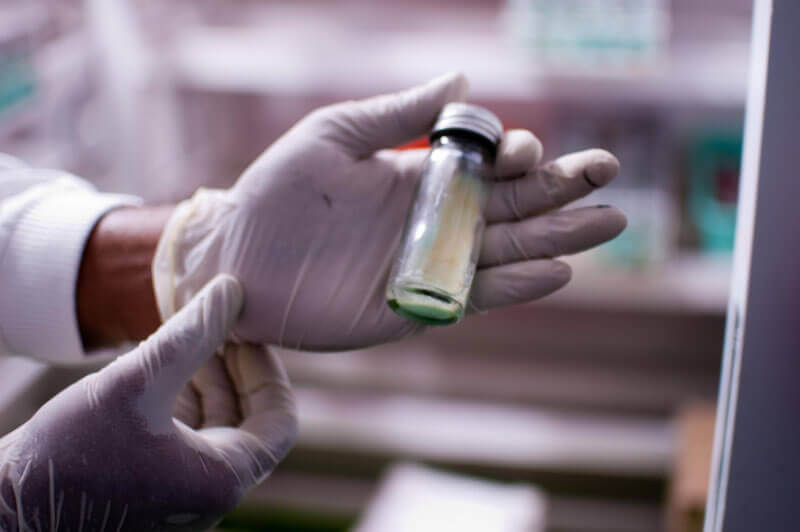Erin Will MortonGHTC
Erin Will Morton is the Director of GHTC.
This post is part of the #MarketsMatter expert blog series. Read the full series here.
The size, strength, and stability of markets dictate how health product developers set priorities and fund research and development (R&D); a 1 percent increase in the potential market size for a drug category leads to a 6 percent increase in the number of medicines introduced in the US market.[i] However, relying on market forces alone to drive health R&D leads to staggering disparities in funding and real-world impact. Today, only 1 to 2 percent of all global investment in health R&D targets neglected diseases, which kill more than 6 million people each year and disproportionately affect low- and middle-income countries (LMICs).
 US Navy Lt. Kimberly Edgel, left, and Christian Baldeviano examine a positive malaria blood smear at Naval Medical Research Unit (NAMRU) 6 in Callao, Peru.
US Navy Lt. Kimberly Edgel, left, and Christian Baldeviano examine a positive malaria blood smear at Naval Medical Research Unit (NAMRU) 6 in Callao, Peru.
When existing market forces alone fall short in ensuring availability of and access to lifesaving health tools, a range of interventions are needed to alter the market and ultimately change the behavior of its actors. Incentives and innovative financing mechanisms are interventions that have proven effective in accelerating R&D and delivering lifesaving vaccines, drugs, diagnostics, and other health tools to those who need them most. Incentives such as advance market commitments (AMCs), volume guarantees, milestone prizes, and priority review vouchers reward developers who conduct neglected disease R&D or guarantee a market for a health product, ensuring that developers are able to recoup the costs of R&D. Innovative financing mechanisms, including mix-method financing, cross-sector partnerships, pooled funding, and competitions directly subsidize and consequently catalyze R&D.
These platforms and partnerships are already accelerating R&D and promoting access to new innovations. AMCs—agreements by procurers to purchase a specified quantity of a new product at a predetermined price, effectively securing a market for product developers—have moved from innovative idea to reality over the past decade. In 2007, Gavi, the Vaccine Alliance launched an AMC for pneumococcal vaccines, raising US$1.5 billion from six public and philanthropic donors to purchase a future vaccine. While there were already two late-stage candidates in the pipeline that met the AMC’s criteria, the commitment created competition and encouraged GlaxoSmithKline (GSK) and Pfizer to adapt the vaccine candidates for low-resource settings. The AMC also stimulated demand; the vaccine has been introduced in more than 50 LMICs, and both GSK and Pfizer scaled up manufacturing to meet the demand, reporting that these decisions were influenced by the existence of the AMC.
Earlier this year, Gavi initiated a similar agreement, signing an advance purchase commitment with Merck, providing $5 million toward the development of an Ebola vaccine. Merck guaranteed that the product would be submitted for licensure by the end of 2017, and 300,000 doses would be made available by May 2016 for use in either a future outbreak or clinical trial. Not only has Ebola historically affected LMICs, but the disease typically emerges in short-term outbreaks, and thus, the market is limited and unstable. This agreement will ensure that a stockpile of vaccines are ready to be deployed during the next outbreak and signals to vaccine developers and manufacturers that cross-sector partnerships can offer a market for emerging and reemerging infectious diseases.
While incentive mechanisms can expedite product development and access to new health tools by creating market demand and new financial incentives, innovative financing mechanisms that directly fund R&D remain critical and have played a tremendous role in bolstering the neglected disease pipeline. The pipeline has grown from 365 products in 2012 to 485 tools today, three-fourths of which are being developed by public-private partnerships, including product development partnerships, which facilitate collaboration across the public, private, and philanthropic sectors, bringing in new resources and diverse expertise. Other innovative financing mechanisms include pooled funds, such as the Global Health Innovative Technology (GHIT) Fund, which is financed by the Japanese government, seven Japanese pharmaceutical companies, and the Bill & Melinda Gates Foundation. The GHIT Fund has brought new investors and resources to the table and is currently supporting nearly 50 drug, vaccine, and diagnostic candidates. Alternately, Grand Challenge programs offer a platform for open innovation, identifying and financing promising ideas to address health and development challenges. Through its Grand Challenges series, the US Agency for International Development has elicited 7,400 ideas and has supported 224 of them, leveraging $125 million in new funding to match the agency’s investment of $76 million.
Markets for neglected disease products are often perceived as insufficient to warrant investments in R&D, and thus, we can’t rely on existing market forces alone to determine R&D funding and priorities. An enabling policy environment, cross-sector partnerships, and innovative financing mechanisms have a critical role to play in galvanizing greater industry engagement and addressing the market failures that inhibit neglected diseases R&D.
The Global Health Technologies Coalition (GHTC) works to save and improve lives by encouraging the research and development of essential health technologies. We are a coalition of more than 25 nonprofit organizations advancing policies to accelerate the creation of new drugs, vaccines, diagnostics, and other health tools that bring healthy lives within reach for all people. GHTC is housed at PATH and funded in part by the Bill & Melinda Gates Foundation. Learn more at www.ghtcoalition.org.
[i] According to the authors of this study, the correlation between market size and new drugs entering the market likely applies beyond the US market, but this data is not readily available. However, the US market has a disproportionate impact on R&D funding and priorities, as it constitutes an estimated 40 percent of the global market. For more information, see the study, published in The Quarterly Journal of Economics, here.